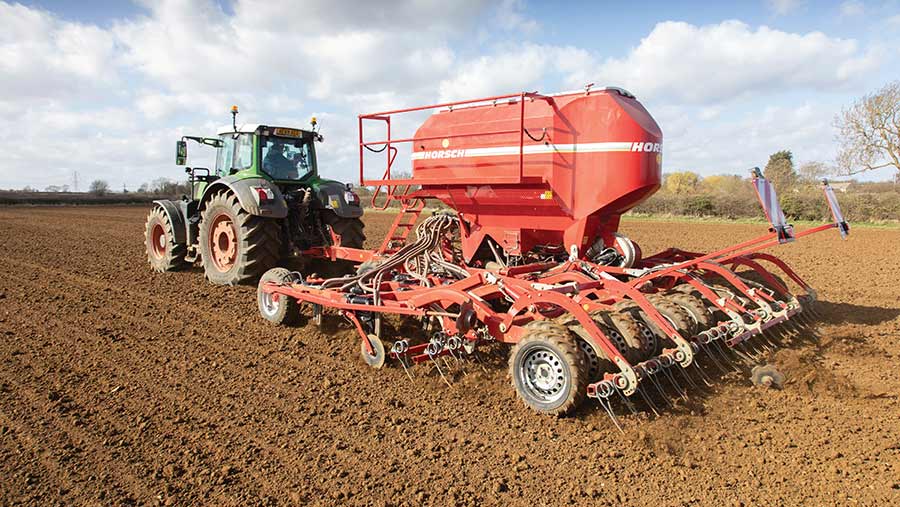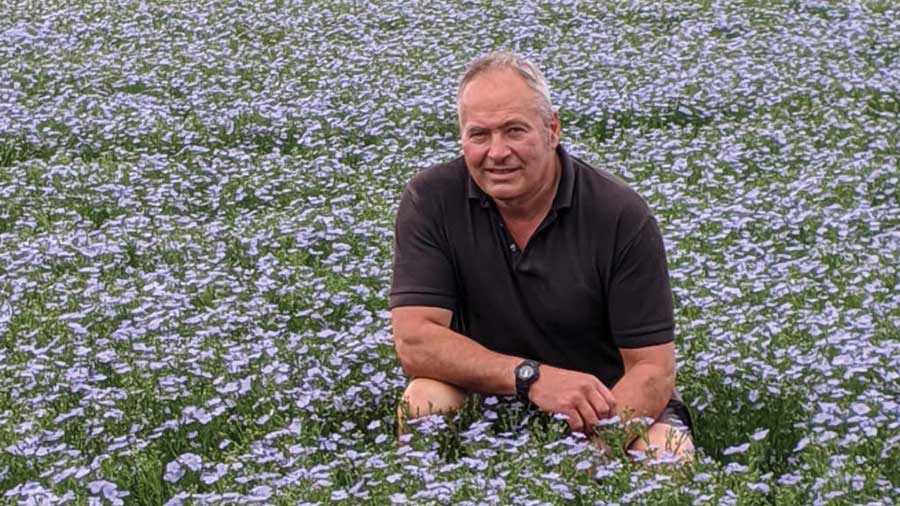Pros and cons of alternative breakcrops to OSR
 © Tim Scrivener
© Tim Scrivener Many oilseed rape growers will be weighing up what alternative breakcrops to grow, with early forecasts suggesting the UK area could struggle to reach 300,000ha next season, a drop of more than 60% from the peak nine years ago.
From its high of 756,000ha, it is a dramatic fall of grace for a crop that, on paper at least, is still one of the best combinable break options.
But the loss of neonicotinoid seed treatments and knock-on establishment issues are proving too much for many growers, forcing them to look for economically and agronomically viable alternatives; no easy task, especially where crops such as potatoes and sugar beet are not an option.
See also: How OSR establishment risk-share schemes compare
Gross margin is important when weighing up alternatives (see “Gross margin comparison”), but there are many other questions to consider, including:
- Is there a local market for the crop? What contracts are available?
- Can I meet contract specifications?
- Does it suit the farm’s soil type, climate, rotation, and equipment?
- Is it a true break from cereal pests and diseases?
- What are the agronomic requirements? Do timings clash with other crops – particularly drilling and harvest?
- Will it affect grassweed control? Can alternative chemistry be used?
- Will it provide an early entry for following wheat?
- What condition will it leave soil in – structure and fertility?
- What are the storage requirements (including segregation)?
“Consider what is right for your business and be realistic about the potential gross margin,” says Velcourt agronomist Ryan Hudson.
Gross margin comparison |
||||
|
Crop |
Yield (t/ha) |
Price (£/t) |
Variable costs (£/ha) |
Gross margin (£/ha) |
|
Winter OSR |
3.70 |
325 |
516 |
686 |
|
Winter field beans |
4.2 |
200 |
275 |
565 |
|
Spring field beans |
4.0 |
210 |
286 |
554 |
|
Spring peas – Blue |
3.8 |
225 |
314 |
541 |
|
Spring peas – Marrowfat |
3.4 |
275 |
396 |
539 |
|
Winter linseed |
2.7 |
350 |
367 |
578 |
|
Spring linseed |
2.0 |
350 |
282 |
418 |
|
Source: Agricultural Budgeting & Costing Book, 90th edition |
||||
Finding local markets is essential, and many alternatives to oilseed rape are comparatively niche crops, so growers may have to consider two or three replacements, he says.
“Keep an open mind; varieties and agronomy have advanced a lot, so don’t discount crops solely because they didn’t work 10 or 20 years ago.”
The pros and cons of the main crops are summarised below, but there are many others, such as maize, rye, pharmaceutical poppies, borage, lupins, or soya.
Mr Husdon suggests there may need to be a shift away from the mindset of putting a crop in the ground every season, and consider other ways of providing a break. This could include rotational fallow with cover crops to improve soil health, environmental stewardship or temporary grass leys.
Leicestershire farmer and Farmers Weekly columnist Joe Stanley is considering exactly this, having decided 2020 will be his last year growing oilseed rape.
“Oilseed rape has been in our rotation for 30 years and was the most financially successful breakcrop.
“But after losing money on it two years running due to cabbage stem flea beetle, we won’t grow it anymore.”
He anticipates switching to a mix of winter beans on heavier land, and temporary grass leys and rotational stewardship elsewhere.
“A lot of our land is light and very stony, which doesn’t suit beans or peas, so we’ve got to look at other options.
“Financially, we will be less well off than with oilseed rape, but lengthening the rotation can only be good for soil health, especially as we may expand the livestock and possibly put some difficult areas into semi-permanent stewardship.”
Examining the options
Below is a table summarising the main advantages and disadvantages of key breakcrop alternatives, based on information from Mr Hudson and growers featured in this article.
Key breakcrop alternatives to OSR |
||
|
Crop |
Advantages |
Disadvantages |
|
Winter beans
|
• Nitrogen fixation benefits following wheat establishment • True cereal break • Suits heavier land • Decent gross margin possible • Opportunity to direct drill wheat into stubble |
• Poor blackgrass competition • Variable yield and gross margin • Less suited to lighter land • Limited chemistry • Bruchid beetle risk |
|
Spring beans |
As above, plus… • Allows extra time for blackgrass control or soil improvements |
• Establishment risk in dry weather • Hot, dry springs can reduce flowering and pod set |
|
Field peas |
• Better suited to lighter land than beans • Nitrogen fixation • True cereal break
|
• Sensitive to compaction • Prone to dry springs • Higher input requirement than beans, higher risk • Problematic harvesting on stony ground |
|
Winter linseed |
• Good gross margin possible • Improved varieties and agronomy • Suits different soil types • Harvest timing similar to OSR, allows early entry for wheat |
• Lacks competitiveness against blackgrass • Winter pigeon grazing can be a risk (less so than OSR) • Harvesting care needed (also applies to spring-sown crops) • Limited market for straw – often needs to be burned |
|
Spring linseed |
• Option for grassweed control before drilling • Avoids winter pigeon risk |
• Later to harvest (end of August/early September) • Prone to dry springs • Flax beetle can be a greater threat |
|
Winter oats |
• Suits lighter soils or heavy land without blackgrass • Easy to grow • Low input, low risk • Good scavenger for water and nutrients (winter and spring oats) • Straw demand |
• Needs a contract in advance as open market price can be poor • Lacks grassweed competitiveness • Wheat after oats can be slower to develop as oats leave little residual nitrogen and high C:N ratio of residues uses N to break down • Frit fly risk in following wheat may increase after oats |
|
Spring oats |
• Possible alternative where grassweeds are an issue, as time to control before drilling |
• Prone to low specific weight after dry springs, therefore harder to achieve contract specifications |
Juggling alternatives
Essex contractor Neil Byford is exploring alternatives to oilseed rape, which has been dropped from his clients’ farms in favour of different breakcrops.

This includes 60ha of winter linseed, 20ha spring linseed, 60ha spring beans and 100ha of canary seed.
“Any spring crop is reliant on rainfall, especially linseed. But even this year, many crops look well.”
Spring beans were drilled with a Claydon as soon as conditions allowed in early February, so went into moist soils and established well before land dried out.
Other crops are often direct-sown into stubble, although every field is treated individually.
Regarding agronomy, Mr Byford acknowledges pigeon grazing has affected winter linseed, although less-so than OSR, while winter linseed appears less prone to flax beetle damage than spring linseed.
Beans and linseed both provide a good break ahead of first wheats, with the residual nitrogen from beans giving a noticeable boost to autumn establishment.
Lower slug pressure is a welcome benefit of no OSR in the rotation, especially after the loss of clothianidin-based seed treatments, he notes.
Canary seed, like linseed, is grown on contract and provides a low-input break.
It is sown in April/ May, giving time for blackgrass control, and requires less than 50 units/ha of nitrogen, a broad-leaved herbicide and growth regulator.
“It grows slowly and is quite straggly at first, but is usually harvested straight after linseed.
“It can be desiccated if needed, but we’ve not had to in the past two years.”
Storage and management logistics are an important consideration, especially if a range of crops are grown.
Using on-farm and central storage helps manage this challenge.
Linseed replaces OSR
Linseed is the go-to option for James Chamberlain, who farms 600ha of predominantly light sand/gravel/silty clay south of Derby.
This year, he is growing 200ha, including Alpaga winter and Aquarius and Empress spring linseed on seed contract for Premium Crops.
“I’m a big fan and have always grown linseed, So after losing 131ha of oilseed rape to cabbage stem flea beetle last year, we put that land into spring linseed as well.”
He acknowledges the crop, like any, has challenges, but insists these can be overcome by following well-defined agronomy guidelines.
Harvesting, for example, is largely trouble-free with new “EasyCut” varieties, providing crops are desiccated properly, combine knives are kept sharp and crops are cut at an even speed in dry conditions to ensure a smooth flow.
Good establishment is key to the success of winter and spring linseed, so seed-beds must be fine and level to ensure good seed-to-soil contact. “We cultivate, power-harrow, drill and roll virtually all our land.”
Sowing into warm soil is also vital for quick establishment, especially in spring, when crops must outgrow the flax beetle risk, Mr Chamberlain adds.
As with any spring crop, waiting for soils to warm increases the risk of land drying out before roots are fully established, so it may be worthwhile spreading the risk with a combination of autumn and spring-sown varieties.
He values bringing different chemistry into the rotation, something that is becoming more challenging with the loss of actives and already limited options in many crops.
“Fortunately, blackgrass isn’t a major issue for us. If it was, we would have to look at alternatives, but the options are pretty limited and none are as good as oilseed rape used to be.”

